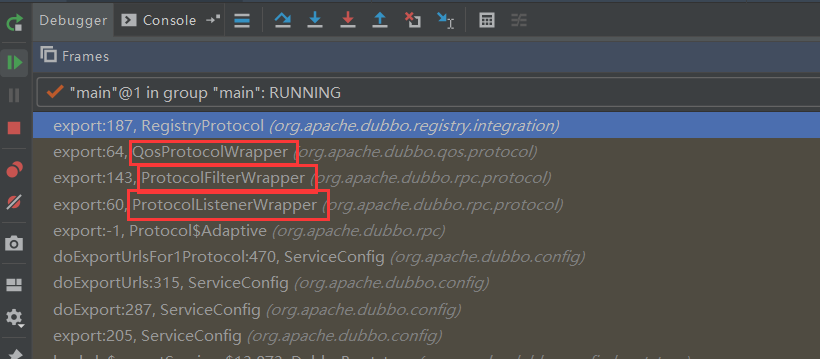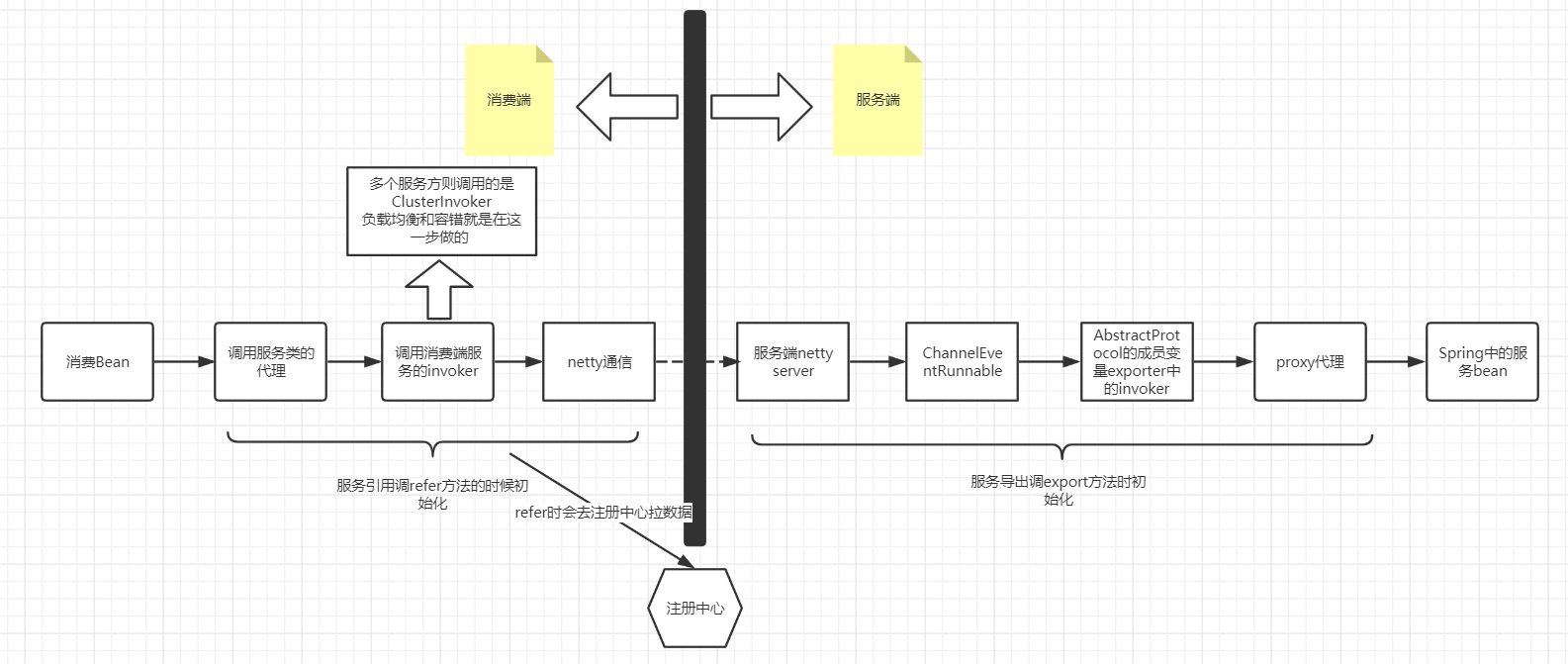【2020-03-28】Dubbo源码杂谈
前言
本周空闲时间利用了百分之六七十的样子。主要将Dubbo官网文档和本地代码debug结合起来学习,基本看完了服务导出、服务引入以及服务调用的过程,暂未涉及路由、字典等功能。下面对这一周的收获进行一下总结梳理。
一、基于事件驱动的服务导出
提起服务导出,不要被它的名字误导了,通俗点说就是服务的暴露和注册。服务的暴露是指将服务端的端口开放,等待消费端来连接。服务的注册即将服务信息注册到注册中心。针对服务暴露和注册的具体流程,可参见博主之前的一篇文章 https://www.cnblogs.com/zzq6032010/p/11275478.html ,讲述的比较详细,暂不赘述。
注重提一下的是Dubbo启动服务暴露和注册的时机,是采用的事件驱动来触发的,跟SpringBoot有点神似。这种通过事件驱动来触发特定逻辑的方式,在实际开发工作中也可以灵活使用。
二、服务引入及SPI
对于Dubbo的SPI自适应扩展,可参见博主之前的一篇文章 https://www.cnblogs.com/zzq6032010/p/11219611.html,但此篇文章当时写的比较浅显,还未悟得全部。
下面以Protocol类为例,看一下在ServiceConfig类中的成员变量 Protocol protocol = ExtensionLoader.getExtensionLoader(Protocol.class).getAdaptiveExtension() 是什么样子。
package org.apache.dubbo.rpc;
import org.apache.dubbo.common.extension.ExtensionLoader;
public class Protocol$Adaptive implements org.apache.dubbo.rpc.Protocol { public void destroy() {
throw new UnsupportedOperationException("The method public abstract void org.apache.dubbo.rpc.Protocol.destroy() of interface org.apache.dubbo.rpc.Protocol is not adaptive method!");
} public int getDefaultPort() {
throw new UnsupportedOperationException("The method public abstract int org.apache.dubbo.rpc.Protocol.getDefaultPort() of interface org.apache.dubbo.rpc.Protocol is not adaptive method!");
} public org.apache.dubbo.rpc.Exporter export(org.apache.dubbo.rpc.Invoker arg0) throws org.apache.dubbo.rpc.RpcException {
if (arg0 == null) throw new IllegalArgumentException("org.apache.dubbo.rpc.Invoker argument == null");
if (arg0.getUrl() == null) throw new IllegalArgumentException("org.apache.dubbo.rpc.Invoker argument getUrl() == null");
org.apache.dubbo.common.URL url = arg0.getUrl();
String extName = ( url.getProtocol() == null ? "dubbo" : url.getProtocol() );
if(extName == null) throw new IllegalStateException("Failed to get extension (org.apache.dubbo.rpc.Protocol) name from url (" + url.toString() + ") use keys([protocol])");
org.apache.dubbo.rpc.Protocol extension = (org.apache.dubbo.rpc.Protocol)ExtensionLoader.getExtensionLoader(org.apache.dubbo.rpc.Protocol.class).getExtension(extName);
return extension.export(arg0);
} public org.apache.dubbo.rpc.Invoker refer(java.lang.Class arg0, org.apache.dubbo.common.URL arg1) throws org.apache.dubbo.rpc.RpcException {
if (arg1 == null) throw new IllegalArgumentException("url == null");
org.apache.dubbo.common.URL url = arg1;
String extName = ( url.getProtocol() == null ? "dubbo" : url.getProtocol() );
if(extName == null) throw new IllegalStateException("Failed to get extension (org.apache.dubbo.rpc.Protocol) name from url (" + url.toString() + ") use keys([protocol])");
org.apache.dubbo.rpc.Protocol extension = (org.apache.dubbo.rpc.Protocol)ExtensionLoader.getExtensionLoader(org.apache.dubbo.rpc.Protocol.class).getExtension(extName);
return extension.refer(arg0, arg1);
} public java.util.List getServers() {
throw new UnsupportedOperationException("The method public default java.util.List org.apache.dubbo.rpc.Protocol.getServers() of interface org.apache.dubbo.rpc.Protocol is not adaptive method!");
}
}
这就是getAdaptiveExtension()之后得到的代理类,可见在初始化ServiceConfig时先获取的protocol只是一个代理Protocol类,程序运行时再通过传入的Url来判断具体使用哪个Protocol实现类。这才是SPI自适应扩展的精髓所在。
除此之外,在通过getExtension方法获取最终实现类时,还要经过wrapper类的包装。详见ExtensionLoader类中的如下方法:
private T createExtension(String name) {
Class<?> clazz = getExtensionClasses().get(name);
if (clazz == null) {
throw findException(name);
}
try {
T instance = (T) EXTENSION_INSTANCES.get(clazz);
if (instance == null) {
EXTENSION_INSTANCES.putIfAbsent(clazz, clazz.newInstance());
instance = (T) EXTENSION_INSTANCES.get(clazz);
}
injectExtension(instance);
Set<Class<?>> wrapperClasses = cachedWrapperClasses;
if (CollectionUtils.isNotEmpty(wrapperClasses)) {
for (Class<?> wrapperClass : wrapperClasses) {
instance = injectExtension((T) wrapperClass.getConstructor(type).newInstance(instance));
}
}
initExtension(instance);
return instance;
} catch (Throwable t) {
throw new IllegalStateException("Extension instance (name: " + name + ", class: " +
type + ") couldn't be instantiated: " + t.getMessage(), t);
}
}
如果接口存在包装类,则在第16行进行wrapper类的处理,将当前instance封装进包装类中,再返回包装类的实例,即通过这一行代码实现了扩展类的装饰器模式改造。
此处同样以Protocol类为例,Url中的协议是registry,那么我最终执行到RegistryProtocol的export方法时栈调用路径是这样的:

即中间经过了三层Wrapper的封装,每层都有自己特定的功能,且各层之间互不影响。Dubbo在很多自适应扩展接口处加了类似这样的装饰扩展,程序的可扩展设计还可以这样玩,Interesting!
服务引入的流程大体是这样的:消费端从注册中心获取服务端信息,封装成Invoker,再封装成代理类注入消费端Spring容器。流程比较简单,可自行根据上一节的内容debug调试。
三、服务调用的疑问
之前未看Dubbo源码时一直有一个疑问:dubbo的消费端代理类调用服务端接口进行消费时,是通过netty将消息发送过去的,服务端在接收到消息后,是如何调用的服务端目标类中的方法?反射吗?反射可以调用到方法,但是没法解决依赖的问题,而且正常情况服务端调用应该也是Spring容器中已经实例化好的的服务对象,那是如何通过netty的消息找到Spring中的对象的?
实际dubbo处理的很简单,只要在服务暴露的时候将暴露的服务自己存起来就好了,等消费端传过来消息的时候,直接去map里面取,取到的就是Spring中封装的那个服务对象,very easy。

服务调用过程草图
如上图所示,服务调用的流程大体是这样的:调用之后通过client远程连接到server,在server端维护了暴露服务的一个map,服务端接收到请求后去map获取Exporter,exporter中有服务端封装好的Invoker,持有Spring中的服务bean,最终完成调用。中间还涉及很多细节,比如netty的封装与调用,序列化反序列化,负载均衡和容错处理等。
小结
Dubbo作为一个优秀的rpc服务框架,其优势不止在于它的rpc过程,还在于更多细节模块的实现以及可扩展的设计,比如序列化处理、负载均衡、容错、netty的线程调度、路由、字典... 内容挺多的,后面打算针对dubbo的四大负载均衡算法做一下研究,浅尝辄止,不求甚解!
【2020-03-28】Dubbo源码杂谈的更多相关文章
- dubbo面试题,会这些说明你真正看懂了dubbo源码
整理了一些dubbo可能会被面试的面试题,感觉非常不错.如果你基本能回答说明你看懂了dubbo源码,对dubbo了解的足够全面.你可以尝试看能不能回答下.我们一起看下有哪些问题吧? 1.dubbo中& ...
- dubbo源码分析6-telnet方式的管理实现
dubbo源码分析1-reference bean创建 dubbo源码分析2-reference bean发起服务方法调用 dubbo源码分析3-service bean的创建与发布 dubbo源码分 ...
- dubbo源码分析1-reference bean创建
dubbo源码分析1-reference bean创建 dubbo源码分析2-reference bean发起服务方法调用 dubbo源码分析3-service bean的创建与发布 dubbo源码分 ...
- dubbo源码分析2-reference bean发起服务方法调用
dubbo源码分析1-reference bean创建 dubbo源码分析2-reference bean发起服务方法调用 dubbo源码分析3-service bean的创建与发布 dubbo源码分 ...
- dubbo源码分析3-service bean的创建与发布
dubbo源码分析1-reference bean创建 dubbo源码分析2-reference bean发起服务方法调用 dubbo源码分析3-service bean的创建与发布 dubbo源码分 ...
- dubbo源码分析4-基于netty的dubbo协议的server
dubbo源码分析1-reference bean创建 dubbo源码分析2-reference bean发起服务方法调用 dubbo源码分析3-service bean的创建与发布 dubbo源码分 ...
- dubbo源码分析5-dubbo的扩展点机制
dubbo源码分析1-reference bean创建 dubbo源码分析2-reference bean发起服务方法调用 dubbo源码分析3-service bean的创建与发布 dubbo源码分 ...
- dubbo源码之四——服务发布二
dubbo版本:2.5.4 2. 服务提供者暴露一个服务的详细过程 上图是服务提供者暴露服务的主过程: 首先ServiceConfig类拿到对外提供服务的实际类ref(如:HelloWorldImpl ...
- dubbo源码之二——dubbo入口
dubbo源码版本:2.5.4 dubbo-contaner-api com.alibaba.dubbo.container dubbo-demo-consumer com.alibaba.dubbo ...
随机推荐
- Apache JMeter--1基础介绍
一.JMeter 介绍 近期公司要做jmeter调研,将性能测试推广到全部测试组,便一边学习一边做记录. Apache JMeter是100%纯JAVA桌面应用程序,是一款优秀的开源性能测试工具,被设 ...
- Ubuntu18.04安装Fabric
本文介绍如何在Ubuntu18.04中搭建Fabric1.4实验环境,默认使用root用户. 1.安装Golang 首先下载Golang安装包,安装包可以从这里下载.这里下载的是go1.13.4.li ...
- runR
Linux下使用R 运行linux下的R脚本 编写R文件 新建后缀名为R的文件 写入R程序 在脚本首行加入 1 运行R文件 这里有两种方式 大专栏 runR进入R的环境">进入R的环 ...
- Jquery 实现原理深入学习(3)
前言 1.总体结构 √ 2.构建函数 √ 3.each功能函数实现 √ 4.map功能函数实现 √ 5.sizzle初步学习 6.attr功能函数实现 7.toggleClass功能函数实现(好伤) ...
- 利用matplotlib进行数据可视化
matplotlib是python中的一个画图库,继承了matlib(从名字上也看得出来)的优点和语法,所以对于熟悉matlib的用户来说是十分友好的. pylab和pyplot 关于pylab和py ...
- 聊一聊MyBatis 和 SQL 注入间的恩恩怨怨
整理了一些Java方面的架构.面试资料(微服务.集群.分布式.中间件等),有需要的小伙伴可以关注公众号[程序员内点事],无套路自行领取 更多优选 一口气说出 9种 分布式ID生成方式,面试官有点懵了 ...
- android通过NFC开启/关闭NTAG213的密码保护功能
穷遍全网没有资料,最后找到了官方的寄存器文档和StackOverflow上找到了解决方案 首先要用 MifareUltralight 来进行操作,在onNewIntent处先校验返回的tag是否包含了 ...
- MySQL集群MGR架构for单主模式
本文转载自: https://www.93bok.com MGR简介 MySQL Group Replication(简称MGR)是MySQL官方于2016年12月推出的一个全新的高可用与高扩展的解决 ...
- BeetleX之XRPC远程委托调用
BeetleX.XRPC是基于接口的远程通讯组件,它不紧可以把接口提供客户端调用,同样也支持服务端创建客户端的接口实例并主动调用客户端的方法.接口有着非常的规范性和约束性,但前提你是必须制定相应的接口 ...
- 【Amaple教程】6. 路由配置
在 第1节<启动路由> 章节中为了能让单页应用顺利跑起来,我们提前介绍了简单的路由配置方法.我们已了解路由配置的目的是指定不同的url下对应的 模块节点(也叫做模块容器)内应该显示哪个模块 ...
